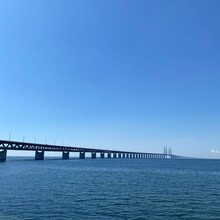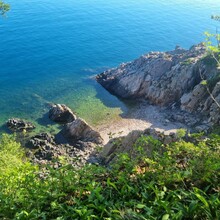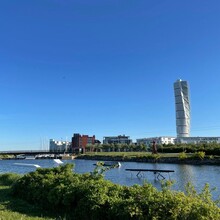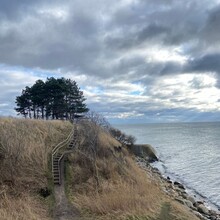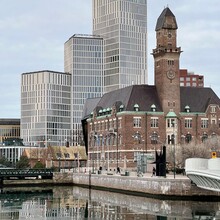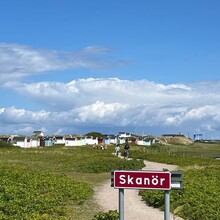From Utvälinge (just west of Ängelholm) in the north to Falsterbonäset Peninsula in the south with a circular trail around the Falsterbonäset Peninsula.
Starting at Utvälinge you’ll be able to follow the brickmaking process, including holes from which the clay was dug, an historically designated brick factory, and next to the island of Rönnen, you’ll find rails and a harbour for transport. This section follows the coast along Skälderviken Bay. The shallow bay and all the small lagoons along the shore are home to rare fauna, including a variety of birds, fish larvae and small animals. The high salt content in the water attracts crayfish and crabs. Further to Arild, footpaths lead you across coastal meadows with abundant birdlife, and on a narrow coastal road, you’ll encounter one fishing village after another. Historical findings attest to Stone Age hunting. The section to Mölle is quite difficult. Winding streets lead you through the well-known fishing villages, and trails pass through dramatic pastureland. To the west is Kullaberg with its caves, rauks, forests and views. From the top of Mount Håkull, 187.5 metres above sea level, you can see for miles and miles. Continuing south, you’ll pass popular beaches, Ransvik and Mölle. In the 1890s, Mölle shocked the rest of Sweden with the introduction of the country’s first mixed bathing facility.Leaving Mölle, also known as the pottery town, you continue on shore walks, past gnarled pine forests and charming fishing villages. From time to time, you’ll find coastal heaths where the wind has created dunes, and the flora is definitely unique.
Coastal paths, through gnarly pine woodlands to the town of Höganäs – famous for its ceramics and 200 million-year-old footprints, and then to the fishing village of Viken. This stretch of trail includes coastal heathlands and sand dunes where the vegetation is truly special. Towards Helsingborg the trail follows one long, rocky cliff on the northwest coast of Skåne. Sculpted by powerful sea waves and currents and with springs gushing from its sides, the beauty and strategic access to Öresund Sound inspired splendid castles. You can even visit Europe’s most beautiful park on your way to the historic city of Helsingborg. Towards Landskrona there are sandy paths on the edge of cliffs and easy walking on the small coastal roads of west Skåne –with beautiful views over the Öresund Sound. Take a ferry out to the unique island of Ven, or contemplate the passing of time at Stone Age burials. Reminders of industrial history and the wars fought over the last few centuries line the trail.Along this stretch of trail, and indeed along Skåne’s entire coastline, the Swedish military built concrete bunkers to protect Sweden during World War II. Before you reach Bjärred the trail goes through open countryside, leafy nature reserves, and along the coast to Bjärred’s Långa Brygga Pier, a popular tourist attraction dating back to the 1800s. Just after passing the Kävlinge River, you can make a detour to Borgeby Castle. The trail then passes through Borgeby, along the coast. Outside of Malmö, the stage between Bulltofta recreation area and Malmö is full of experiences and contrasts. The walk through Sweden's third largest city, which offers beautiful cemeteries, urban pulse, unique buildings and lots of lovely stops in the form of shopping, food and culture.
Through residential areas, on sidewalks and on a long beach promenade, you run past an old shipyard, world-famous architecture, and rolling sand dunes with bathing piers that invite you to take a refreshing dip. The path goes through historical land, in the area around Västra hamnen and Dockan, Kockums began its shipbuilding industry in Västra Hamnen at the beginning of the 20th century, which continued for almost 100 years. Here stood the famous Kockumskranen, a 146-meter-high crane that until 2002 was a landmark for Malmö, but which was then moved to a shipyard in South Korea. In recent decades, Västra hamnen has undergone major changes, the starting point being the housing fair Bo01, which was organized in 2001. In addition to the exhibition area, a brand new district with exciting architecture and two brand new bathing areas were built, which the whole of Malmö enjoys during the summer months. Along the way up to Riberborgsstranden, it is hard to miss Turning torso, the 190-meter-high residential building designed by the world-famous architect Santiago Calatrava.
Towards Lernacken (when you have left Malmö City), a headland that is largely artificial and consists of residual products from Limhamn's lime quarry, which is located a short distance away. Here you have a magnificent view of the Öresund Bridge, which was inaugurated in 2000. The Öresund connection includes a 7.8 km long bridge and a 4.1 km long man-made island called Pepparholmen.
Like the stage across the Falsterbo peninsula, between Höllviken and Skanörs harbour, you are treated to a large portion of sand. The entire peninsula is made up of this material and the surrounding sea is a sandy walking area with a lively fish life to say the least. The headland is also an internationally known migratory bird location.

